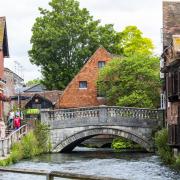Smugglers, treacle mines and the world’s tallest tower, this New Forest village has tales aplenty.
A BIT ABOUT SWAY
Sway parish in the New Forest was created in 1879 when lands were hived off from the adjoining parish of Boldre. But, it goes much further back than that, possibly, even, to the Bronze Age. It’s Anglo Saxon name, Svieia, means ‘noisy stream’ and it is listed no less than four times in the Domesday Book. Like many places it’s been bickered over by assorted aristocrats over the centuries, emerging to become one of the forest’s nicest villages.
-----------------------------------------------------------------------------------------------------
FAMOUS BOOK
When Capt. Marryat wrote Children of the New Forest in 1847 he could never have imagined that his tale about the plucky Beverley children, who were orphaned in the English Civil War and hid from the Roundheads in the New Forest, would become such a hit; adapted an impressive four times for television. The children’s home was based in Arnewood House which stood to the south of the village, before it was sadly destroyed by a fire.
-----------------------------------------------------------------------------------------------------
A TALL TALE
When Andrew Thomas Turton Peterson became a spiritualist he consulted a medium who put him in touch with Sir Christopher Wren. The late architect reportedly told him to build a tower to help bring employment to the area, so in 1879 Peterson built Sway Tower, or Peterson’s Folly as it was locally known. The amazing edifice is still the tallest non-reinforced concrete structure in the world at 66 metres high, and is now privately owned.
-----------------------------------------------------------------------------------------------------
LEGACY OF WAR
Just as Sway Tower was used by the Home Guard as a WW2 lookout, the RAF found use for land to the south of the village to use as an emergency landing ground for aircraft at nearby RAF Christchurch. Planes were parked there overnight to keep them safe from German attack but sadly, the plan failed and the Luftwaffe bombed on several occasions. In 1941 the site was abandoned and after the war, pieces of shrapnel were found in the thatch roofs.
-----------------------------------------------------------------------------------------------------
FOOD AND DRINK
The Hare and Hounds is a 200-year-old, family-owned pub on Durnstown in Sway which has everything you’d hope to find in a local inn, with traditional grub, a vegetarian and a children’s menu. The Silver Hind in Station Road is a bar and restaurant which offers a set lunch with delights including oak-smoked salmon with capers. Check out, too, The Manor at Sway, a highly-regarded boutique hotel which offers top-notch foodie fare.
-----------------------------------------------------------------------------------------------------
RAILWAY HASSLE
The coming of the railways changed Britain irrevocably but were not without their problems. Sway was delighted to get its own station on the line to Bournemouth but due to various problems the station house was built a full two years before the track appeared, in 1888. The direct line from Brockenhurst to Christchurch was so delayed that the construction company went bust and, more tragically still, at least ten workers lost their lives.
-----------------------------------------------------------------------------------------------------
TREACLE MINES
The ‘treacle’ was the nickname given to the pernicious Barton Clay, through which the unfortunate navvies building the railway line had to cut. Engineer Joseph Firbank described the substance as: ‘treacherous and slippery in the highest degree.’ Workers complained about having to scrape the clay off everything, adding to their strenuous workload. The Treacle Mines were a local joke destination, along with ‘Sway Docks’.
-----------------------------------------------------------------------------------------------------
SMUGGLER’S HAUNT
The good folk of Sway may be upstanding now but only a few hundred years ago were being described by their own vicar as ‘little better than bandits’. The reason? Smuggling! Due to punitive taxes, smuggling was a widespread activity and Sway was no exception. The village lay on an established route from the coast up to Beaulieu. Nearby Boldre church was used as a contraband store, as were the cellars of Sway House.
-----------------------------------------------------------------------------------------------------
WHAT’S GOING ON?
Thanks to ArtSway – plenty! The art and culture organisation was founded in 1997 and continues to programme exciting exhibitions, showcasing national and international artists from its base in Station Road. It also runs artist-led courses and workshops for adults and children as well as gallery talks and events. Sway village Hall is the scene for popular drama productions, live music and dances and the village also has a thriving cricket team.
-----------------------------------------------------------------------------------------------------
WINE TIME
Named after the sandy Marl clay, upon which its vines grow, The Marlings in Mead End Road is one of the oldest vineyards in Hampshire. The 30-year-old vineyard is famed for its Sparkling Rosé, made using traditional methods, from a range of still white and rosé wines and its sparkling Rose Brut won Wine of the Year 2019. The vineyard are offering a full delivery service so you can still enjoy their wines at home. marlingsvineyard.co.uk
-----------------------------------------------------------------------------------------------------



























